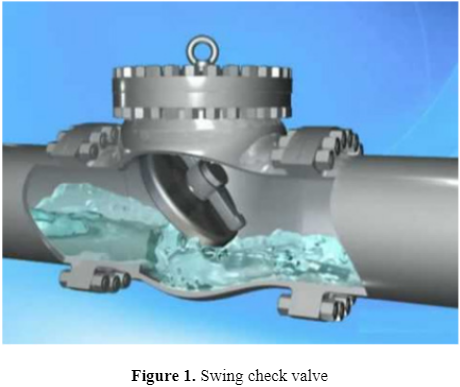Additionally, the function of a check valve is to stop massive backflow when a pipe breaks and prevent backflow toward lower pressure. Generally speaking, a check valve has no requirement for operators and the valve is operated automatically through fluid flow or flow reversal. In a swing check valve, the closure member swings around the hinge, which is mounted in the seat. Figure 1 shows a swing check valve with the disk moving away from the seat by the force of the water to keep the valve open.

A swing check valve is an economic option of check valve with a high slamming effect . Although slamming is a common problem associated with check valves, not much information has been published about how to prevent and predict its occurrence. Check valve slam occurs after pump stoppage when the forward flow reverses and flows back toward the pump before the check valve is fully closed. The reverse flow is stopped by closing the valve, causing slamming and water hammering. We believe that the noise associated with the slam is not the impact of the disk into the seat, but instead, it is related to rapid reverse flow.
On the other hand, we believe that not only the return flow, but also the weight of the disk, has an impact on slamming, hammering, and shutoff characteristics of the valve. Research conducted to understand the slamming and closing characteristics of check valves has described the check valve slam as a two-step process. First, after pump stoppage, the flow reverses and may flow backward through the check valve before it can fully close. The second step happens when the closure member stops the reverse flow suddenly.
It was suggested that a check valve must close either very rapidly before reverse flow occurs, or very slowly once reverse flow has begun. Therefore, it was suggested that one way to close the disk rapidly is to assist the motion of the disk with a spring [8]. Dual plate check valves use a spring for closing the check valve disk, so dual plate check valves are more popular than swing check valves because they have a low slamming effect.
Additionally, a dual plate check valve can be designed to be more compact than a swing check valve in a wafer (flangeless) design. Figure 2 compares the closing action of dual plate and swing check valves closing actions. The slamming effect is much higher in a swing check valve, which is closed through the disk weight force. In a dual plate check valve, slamming the disks on the seat is lower than swing check valve due to spring forceassistance in closing the plates rather than the weight of the plates. In addition, the disk weight in a dual plate check valve is distributed between two parts rather than one.

The advantages of a dual plate check valve compared to a swing check valve are not limited to space saving and lower slamming rate. The total cost of a dual plate check valve including the sum of initial cost, maintenance cost, and energy cost, is less than a swing check valve. The swing check valve is almost twice as expensive based on the research. Swing check valve has more pressure drop compared to dual plate check so that will increase the energy cost. Additionally, relatively weak connection of the disk of the swing check valve to body increases the chance of disk dismantling during the operation and higher maintenance cost.
